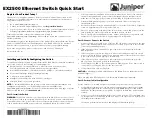
DXS-3350SR Gigabit Layer 3 Switch
The following parameters may be viewed or modified:
Parameter
Description
VLAN ID
This is the VLAN ID that, along with the VLAN Name, identifies the VLAN the user
wishes to modify the IGMP Snooping Settings for.
VLAN Name
This is the VLAN Name that, along with the VLAN ID, identifies the VLAN the user
wishes to modify the IGMP Snooping Settings for.
Query Interval
The Query Interval field is used to set the time (in seconds) between transmitting
IGMP queries. Entries between 1 and 65535 seconds are allowed. Default = 125.
Max Response Time
This determines the maximum amount of time in seconds allowed before sending an
IGMP response report. The Max Response Time field allows an entry between 1 and
25 (seconds). Default = 10.
Robustness Variable
Adjust this variable according to expected packet loss. If packet loss on the VLAN is
expected to be high, the Robustness Variable should be increased to accommodate
increased packet loss. This entry field allows an entry of 1 to 255. Default = 2.
Last Member Query
Interval
This field specifies the maximum amount of time between group-specific query
messages, including those sent in response to leave group messages. Default = 1.
Host Timeout
This is the maximum amount of time in seconds allowed for a host to continue
membership in a multicast group without the Switch receiving a host membership
report. Default = 260.
Route Timeout
This is the maximum amount of time in seconds a route is kept in the forwarding table
without receiving a membership report. Default = 260.
Leave Timer
This specifies the maximum amount of time in seconds between the Switch receiving
a leave group message from a host, and the Switch issuing a group membership
query. If no response to the membership query is received before the Leave Timer
expires, the (multicast) forwarding entry for that host is deleted.
Querier State
Choose
Enabled
to enable transmitting IGMP Query packets or
Disabled
to disable.
The default is
Disabled
.
State
Select
Enabled
to implement IGMP Snooping. This field is
Disabled
by default.
Click
Apply
to implement the new settings. Click the
Show All IGMP Group Entries
link to return to the
Current IGMP
Snooping Group Entrie
s window.
Static Router Ports
A static router port is a port that has a multicast router attached to it. Generally, this router would have a connection to a
WAN or to the Internet. Establishing a router port will allow multicast packets coming from the router to be propagated
through the network, as well as allowing multicast messages (IGMP) coming from the network to be propagated to the
router.
A router port has the following behavior characteristics:
•
All IGMP Report packets will be forwarded to the router port.
•
IGMP queries (from the router port) will be flooded to all ports.
All UDP multicast packets will be forwarded to the router port. Because routers do not send IGMP reports or implement
IGMP snooping, a multicast router connected to the router port of a Layer 3 Switch would not be able to receive UDP data
streams unless the UDP multicast packets were all forwarded to the router port.
59
Summary of Contents for xStack DXS-3350SR
Page 114: ...DXS 3350SR Gigabit Layer 3 Switch Figure 6 56 Access Profile Configuration IP 105 ...
Page 118: ...DXS 3350SR Gigabit Layer 3 Switch Figure 6 59 Access Rule Configuration window IP window 109 ...
Page 125: ...DXS 3350SR Gigabit Layer 3 Switch Figure 6 66 Access Rule Display Packet Content 116 ...
Page 129: ...DXS 3350SR Gigabit Layer 3 Switch Figure 6 70 Second 802 1X Authenticator Settings menu 120 ...
Page 284: ......
















































